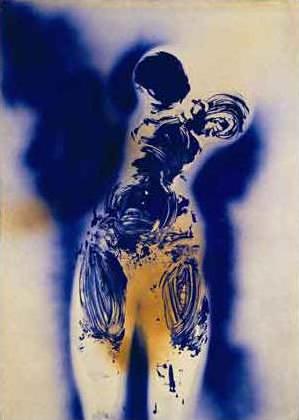Yves Klein
dal 31/1/2005 al 2/5/2005
Segnalato da
31/1/2005
Yves Klein
Guggenheim Museum, Bilbao
A comprehensive retrospective

The Guggenheim Museum Bilbao presents a comprehensive retrospective of the diverse career of French artist Yves Klein (b. Nice, 1928-62). The exhibition encompasses his earliest monochrome paintings in red, pink, orange, yellow, green, white, and black; the famous blue monochromes, sponge reliefs, and sponge sculptures; the Anthropometries; the Monogolds; and his late experiments with the natural elements fire, air, and water. Klein's groundbreaking work, created over only about seven years, anticipated numerous tendencies including Happenings and performance, body art, land art, and aspects of Conceptual art. To this day it continues to exercise a lasting effect.
Although he came from an artistic family-he was born in Cagnes-sur-Mer to Fred Klein, a figurative painter, and Marie Raymond, an abstract painter in the Ecole de Paris tradition-Yves Klein started out as a judoist. His intense engagement with the philosophy and practice of the Asian martial art of judo would have a lasting impact on his conception of art. Klein's studies included 15 months at the renowned Kōdōkan Judo Institute in Tokyo. Strongly influenced by Zen philosophy, the Kōdōkan style of judo represents the union of mind and body, increased receptivity, the search for a state of emptiness, and complete harmony with existence. In addition, Klein from his youth pursued an interest in the mystical Christian teachings of the Rosicrucians. His deep, lifelong affinity for ritual and themes of immateriality and the void are thus not associated with any particular religious dogma but are rather a reflection of his preoccupation with spirituality in general.
Klein's first official appearance on the scene as a visual artist was in 1955, when he submitted his monochrome Expression of the Universe of the Color Orange Lead to the Salon des Réalités Nouvelles. This painting was rejected by the Salon, with the justification that a single color could not in itself constitute a painting. The Guggenheim Museum Bilbao exhibition contains a series of early, nonblue monochromes.
From the outset Klein used a roller instead of a brush in order to eliminate any traces of the artist's hand in the paint application. Therefore color becomes all the more significant. Klein's canvases do not act as planes but rather as pulsing fields of color that extend into space, unbound by the edges of the paintings. For Klein, color was "material sensibility." It manifests his effort to extend a purely visual perception to a comprehensive concept of sensory perception. He challenged his audience to dive into the infinite space of color and to experience an overall heightening of sensitivity to the immaterial.
Klein attributed a particular role to the color blue, which embodied for him the most abstract aspects of tangible and visible nature, such as the sky and the sea. Klein long sought a blue that would correspond to his ideas and for a binder that would retain the pigment's original intensity. The result was International Klein Blue (IKB), a vivid ultramarine blue he developed with the help of a chemist friend and patented. It immediately became his trademark.
Incorporating IKB, Klein's monochrome paintings, sculptures, and actions-presented in solo shows from Paris to Düsseldorf, London, and Milan, quickly earned him international recognition. In keeping with the actionist character of his art, his exhibition openings were fashioned into spectacular artistic events, featuring blue cocktails, among other highlights. In an effort to extend the sensitivity to blue to the entire population, Klein released 1,001 blue balloons into the Parisian sky. The artist went even further in his utopian projects: For example, his Blue Revolution would take the whole of France as a painting surface.
Alongside a representative selection of the early monochromes, the Guggenheim Museum Bilbao is showing a large number of important sponge reliefs and sculptures in blue-as well as a collection of the rarer pink type. The artist impregnated natural sponges with pigments to create these works, as he had done previously for his pioneering, blue, sponge reliefs in the foyer of the theater in Gelsenkirchen, Germany. Klein's interest in architectural issues led to a number of visionary designs for "air architecture," which he executed in collaboration with German architect Werner Ruhnau. Just as radical as Klein's idea of replacing solid walls with streams of air was his room Le Vide (The Void), which he exhibited in a Paris gallery in 1958. Klein went a step beyond monochromy in this work: He completely emptied the gallery and painted its walls white in order to bring the viewer into direct contact with a sensitized and sensitizing space. With this piece, art no longer seemed like an object; instead it could be understood as an artistic presence perceived in space. Le Vide is represented in this exhibition by a film that shows Klein in front of the white walls.
Among the most fascinating works in the exhibition are Klein's Anthropometries, which were controversial at the time they were made. These are blue, pink, and gold imprints of bodies-female or, less often, male models used as "living paintbrushes" alone, as couples, or as groups-left behind on large-format canvas and paper.
Klein captured the traces of wind and rain on canvas in the Cosmogonies, which continue his experiments with natural elements of which the late group of works known as the Fire Paintings was also a part. All these works concerned with transient yet universal phenomena, are the products of sensational actions. Both this group of works and the Anthropometries demonstrate Klein's emphasis on action. They may be understood as relics of events, as it were. "My works are the ashes of my art," the artist remarked.
GUGGENHEIM MUSEUM BILBAO
Abandoibarra Et. 2 48001 Bilbao
Opening hours
Tuesday to Sunday: 10 a.m.-8 p.m.
Monday: closed.
In July and August the Museum opens Monday to Sunday from 10 a.m. to 8 p.m.
Ticket window closes half an hour before Museum closing time.
Galleries begin closing 15 minutes before museum closing time.



